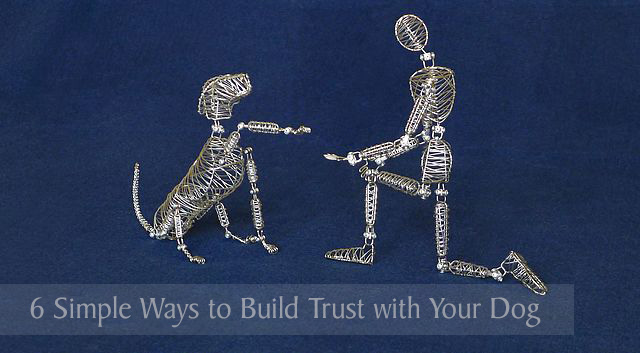 Does your dog trust you? Maybe you never really thought about ways to build trust with your dog before, but this past weekend something happened with Haley that made me realize how important it is. I gave Haley a soft, chewable bone, you know the kind that are similar to dental bones and get a little gummy when chewed. Well, somehow she managed to get a piece of the bone lodged in the back of her mouth in a pocket behind her bottom molars. She started frantically biting and licking and furiously pawing at the side of her face, then she came to me looking for some help.
Does your dog trust you? Maybe you never really thought about ways to build trust with your dog before, but this past weekend something happened with Haley that made me realize how important it is. I gave Haley a soft, chewable bone, you know the kind that are similar to dental bones and get a little gummy when chewed. Well, somehow she managed to get a piece of the bone lodged in the back of her mouth in a pocket behind her bottom molars. She started frantically biting and licking and furiously pawing at the side of her face, then she came to me looking for some help.
I wasn’t sure what was wrong at first, but I noticed a small bulge on the side of her face which turned out to be where the gummy piece of bone was stuck. Weird, right? I tried to push it forward from the outside, but it didn’t budge. Haley knows to calm down and move slowly when I say “Easy”, so I repeatedly gave the command while I carefully slid my index finger back between her gum and molars to dislodge the chunk of bone resting behind her teeth. I never knew something could get stuck back there!
I have to say that I don’t recommend anyone else doing what I did, since a dog’s back molars are powerful slicers that could easily inflict some major damage to fingers (and Haley probably would have eventually dislodged the bone herself) but we dog owners sometimes react impulsively when our dogs are distressed. After it was over, the incident made me realize how much she trusted me by coming to me and by trying to stay calm while I helped her. There was definitely some trust on my part too that she wouldn’t accidentally dismember my finger.
A similar thing happened a few years ago when Haley was biting on a small stick and her top molars sheered off the stick on both sides and it became wedged between her top molars crossing over her tongue. She was very frantic when that happened, but she still ran to me for help. I was lucky that time too that I didn’t get accidentally bitten, but I was able to reach in and dislodge the stick for her.
When these types of incidents happen, it makes me thankful that I have a high level of trust with Haley. Although I touched on this a little bit in my post Building Love, Trust and Respect, I thought I would share a few things that I do with Haley and some other tips for how to build trust with your dog.
6 Simple Ways to Build Trust With Your Dog
1. Be Kind
This should really go without saying, but it’s the most important thing to remember when building trust. Never bully, hit, kick, yell at or be aggressive towards your dog in any way. It’s easy to get frustrated sometimes, especially with a young dog that’s testing boundaries or with a newly adopted dog that hasn’t had proper training, but it’s essential to stay calm and positive even if you arrive home to a destructive chew-fest. Take a deep breath or even step away from the situation for a moment if you need to, then use knowledge and logic instead of emotion to respond to and resolve the issue. Reactive people, just like reactive dogs can have a negative effect on their environment, so always relate to your dog with a calm and gentle demeanor and tone of voice.
2. Be Fair
Fairness is huge to dogs. They like to know the rules and they like it when you follow them as well. You send mixed signals if you have bad timing, or are unpredictable with training or corrections. Being unfair can lead to confusion and a diminished sense of trust. For example, making your dog work for a treat or toy, then not giving it to them when they perform well is unfair. It’s also not fair to cruelly favor one dog over another in a household or to promote jealousy between dogs or between dogs and family members.
3. Be Consistent
Dogs like a predictable environment and stable, dependable owners. They feel comfortable when they know they can depend on you to take care of them and when they understand what behavior is expected of them in return. Trust grows when you and your family members are positive and consistent in the way you relate to your dog. For example, if you allow your dog to jump on you when you’re wearing old clothes but scold him for jumping when you’re wearing dress clothes, he may view you as unpredictable because he doesn’t understand the difference in your attire.
4. Spend Time With Your Dog
The more time you spend with your dog, the more opportunities you have to build trust and develop a mutual understanding and bond with each other. Spend time exercising, playing games, training and just hanging out and relaxing with your dog. Maybe even try
meditating with your dog. Having good experiences together builds a strong bond, so look for ways to include your dog in fun activities.
5. Be Your Dog
Try to see the world through your dog’s eyes and perception. Read some books on dog behavior, study
canine body language or just get down on your dog’s level and try to imagine what he’s thinking and feeling about different situations. This is especially helpful if you’re working on fixing a problem behavior. Approaching the issue from your dog’s point of view, better equips you to understand his motivation for behaving in a certain way and that leads to solutions that work well for both of you.
6. Be Your Dog’s Protector
Understand that it’s your job to protect your dog and keep him safe. He’ll trust you more if you don’t place him in stressful situations where he feels threatened. For example, if your dog is fearful of other dogs, place yourself between an approaching dog and your pup to help him feel protected and allow him to decide if he feels comfortable enough to greet the other dog.
Besides what I’ve already mentioned above, here are some ways that dog owners can unknowingly lose the trust of their dogs.
5 Ways to Lose Your Dog’s Trust
1. Pressuring Your Dog
Forcing a dog to do something they’re uncomfortable with is a sure way to trigger their
opposition reflex and lose their trust. This is especially important if you’re socializing a dog or working to help a dog with fear issues. Provide encouragement and incentives, but allow the dog to work at their own pace to slowly build confidence. Also, don’t pressure a dog by smothering him with hugs and affection. Allowing him to approach you on his terms and in his own time goes a long way in developing a trusting bond.
2. Not Playing Fair
When playing with your dog, take turns being the giver and receiver of toys. If you’re constantly the one taking away or keeping the toys for too long, your dog may be more reluctant to give things up. Practice trading treats for high-valued toys or redirecting your dog to something else that’s fun when you need to take something away. Having a dog that trusts you and will easily give something up comes in handy if you ever need to take something dangerous away from him. Playing fair builds trust and also prevents your dog from getting overly frustrated or excited when playing.
3. Teasing Your Dog
Lightly teasing a dog to build excitement while playing is fun for dogs, but teasing to the point of frustration or over excitement can have a negative effect on the relationship with your dog. Intentionally scaring or disturbing a dog in a mean spirited way or antics that make a dog uncomfortable for the amusement of humans is never a good idea and will obviously cause a loss of trust.
4. Punishing Your Dog After the Fact
This is a common way that dogs can lose some trust in their owners. Dogs normally only associate corrections with what they’re doing at that given moment in time and most researchers believe that
dogs don’t feel complex emotions like guilt. Correcting a dog hours after he chewed your favorite shoes, is most likely going to be perceived by the dog as you suddenly being very angry for a reason that he doesn’t understand. He may then see you as unpredictable or unstable. Another common scenario is the dog that doesn’t come when called and then gets scolded when he eventually goes to his owner. The dog is likely to associate the scolding with going to his owner rather than failing to listen when first called.
5. Not Understanding Fearful Dogs
Fearful dogs need a slow and methodical approach to help them overcome their fear and build confidence. Desensitizing and counter-conditioning (changing the way a dog feels and reacts to the source of their fear) is a good two-part approach to assist the fearful dog. Stressful, uncontrolled exposure to the source of the fear will only make matters worse and will surely diminish trust. Seek out a good trainer with experience in the methods mentioned above if you need some help with a fearful dog.
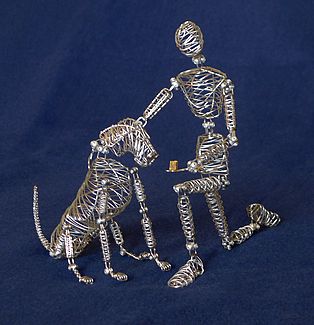 Building trust takes time, but it’s easy when you focus on the little things you do while interacting with your dog everyday. Even small things, like occasionally feeding your dog by hand, work to strengthen trust. Having a dog that trusts you makes everything about living with your dog easier, from getting your dog to come when called, to having an easier time with trimming nails and tending to injuries. Whether you’re starting from scratch with a new puppy or you’ve just adopted a dog, developing a trusting relationship is key to having a close bond and enjoyable relationship with your dog.
Building trust takes time, but it’s easy when you focus on the little things you do while interacting with your dog everyday. Even small things, like occasionally feeding your dog by hand, work to strengthen trust. Having a dog that trusts you makes everything about living with your dog easier, from getting your dog to come when called, to having an easier time with trimming nails and tending to injuries. Whether you’re starting from scratch with a new puppy or you’ve just adopted a dog, developing a trusting relationship is key to having a close bond and enjoyable relationship with your dog.
How much does your dog trust you? I’m sure I’ve overlooked a lot of ways to promote a trusting relationship with your dog, so share your thoughts and ideas too!
 Does your dog trust you? Maybe you never really thought about ways to build trust with your dog before, but this past weekend something happened with Haley that made me realize how important it is. I gave Haley a soft, chewable bone, you know the kind that are similar to dental bones and get a little gummy when chewed. Well, somehow she managed to get a piece of the bone lodged in the back of her mouth in a pocket behind her bottom molars. She started frantically biting and licking and furiously pawing at the side of her face, then she came to me looking for some help.
Does your dog trust you? Maybe you never really thought about ways to build trust with your dog before, but this past weekend something happened with Haley that made me realize how important it is. I gave Haley a soft, chewable bone, you know the kind that are similar to dental bones and get a little gummy when chewed. Well, somehow she managed to get a piece of the bone lodged in the back of her mouth in a pocket behind her bottom molars. She started frantically biting and licking and furiously pawing at the side of her face, then she came to me looking for some help. Building trust takes time, but it’s easy when you focus on the little things you do while interacting with your dog everyday. Even small things, like occasionally feeding your dog by hand, work to strengthen trust. Having a dog that trusts you makes everything about living with your dog easier, from getting your dog to come when called, to having an easier time with trimming nails and tending to injuries. Whether you’re starting from scratch with a new puppy or you’ve just adopted a dog, developing a trusting relationship is key to having a close bond and enjoyable relationship with your dog.
Building trust takes time, but it’s easy when you focus on the little things you do while interacting with your dog everyday. Even small things, like occasionally feeding your dog by hand, work to strengthen trust. Having a dog that trusts you makes everything about living with your dog easier, from getting your dog to come when called, to having an easier time with trimming nails and tending to injuries. Whether you’re starting from scratch with a new puppy or you’ve just adopted a dog, developing a trusting relationship is key to having a close bond and enjoyable relationship with your dog.
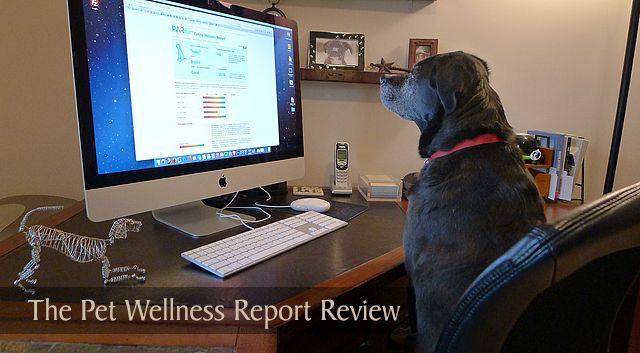
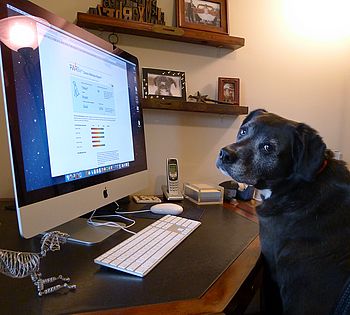
 If you’re thinking about adopting a dog when you have a cat, do you visualize one of those cute photos of a dog and cat lovingly curled up in the same bed or does the expression “fighting like cats and dogs” come to mind and make you a little apprehensive? Yep, it could go either way but if your cat is already familiar and comfortable with dogs, you’ve got half of the battle won and if you’re adopting a dog that was raised around cats, that’s even better. There’s no guarantee that a new dog will get along with your cat but these tips should help improve the odds.
If you’re thinking about adopting a dog when you have a cat, do you visualize one of those cute photos of a dog and cat lovingly curled up in the same bed or does the expression “fighting like cats and dogs” come to mind and make you a little apprehensive? Yep, it could go either way but if your cat is already familiar and comfortable with dogs, you’ve got half of the battle won and if you’re adopting a dog that was raised around cats, that’s even better. There’s no guarantee that a new dog will get along with your cat but these tips should help improve the odds. 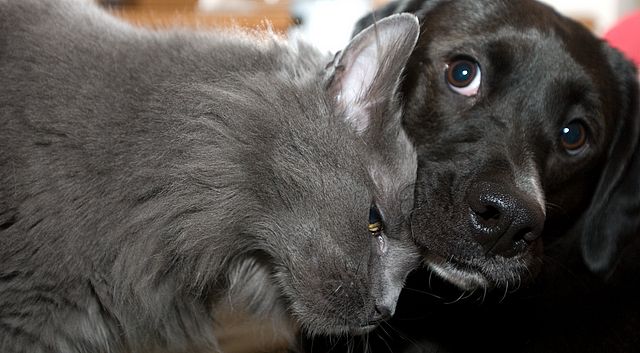 When you’re ready for the big day, take your time and stay calm as your proceed through the steps below to introduce your cat to her new housemate. Some cats take quite awhile to adjust to a dog in the home and you’ll want to be watchful that your cat continues to eat, drink and use the litter box normally.
When you’re ready for the big day, take your time and stay calm as your proceed through the steps below to introduce your cat to her new housemate. Some cats take quite awhile to adjust to a dog in the home and you’ll want to be watchful that your cat continues to eat, drink and use the litter box normally. A few weeks before adopting your dog, create a safe zone inside your home for your cat to use while adjusting to the new dog. Make it only accessible to the cat so she has a place to hide and relax if she feels overwhelmed. The previous owners of our home created this cat portal which leads to the utility room where we kept our cat’s food, water and litter box. Baby gates with integrated cat doors are also ideal for blocking off areas from larger dogs.
A few weeks before adopting your dog, create a safe zone inside your home for your cat to use while adjusting to the new dog. Make it only accessible to the cat so she has a place to hide and relax if she feels overwhelmed. The previous owners of our home created this cat portal which leads to the utility room where we kept our cat’s food, water and litter box. Baby gates with integrated cat doors are also ideal for blocking off areas from larger dogs.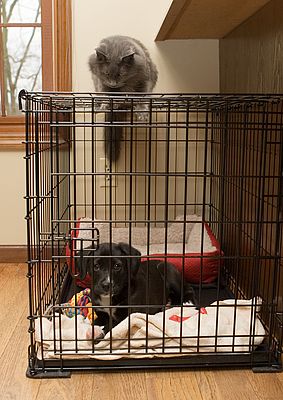 When your dog can be calm around the door, allow them to see and smell each other but be physically separated. A baby gate is perfect for this step or you could put the dog in a crate. Again, redirect the dog if he’s too excited or fixated on the cat, then give them both praise and treats. This is a great time to start training the Leave It command if your dog doesn’t already know it.
When your dog can be calm around the door, allow them to see and smell each other but be physically separated. A baby gate is perfect for this step or you could put the dog in a crate. Again, redirect the dog if he’s too excited or fixated on the cat, then give them both praise and treats. This is a great time to start training the Leave It command if your dog doesn’t already know it.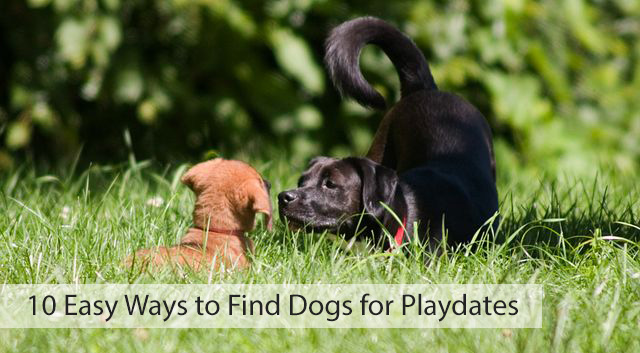 Dogs love playing with other dogs and socializing puppies is essential for raising a well-balanced dog, but sometimes finding other dogs for your dog to interact and play with can be a challenge. For dogs that are overwhelmed by crowded, high-energy dog parks, playdates might be the perfect solution, but how do you find dogs for playdates? It’s not like you can just approach that stranger and her dog you see at the pet store and invite them to your house, right? Start by trying one of the methods below (and you’ll avoid being seen as a creeper.)
Dogs love playing with other dogs and socializing puppies is essential for raising a well-balanced dog, but sometimes finding other dogs for your dog to interact and play with can be a challenge. For dogs that are overwhelmed by crowded, high-energy dog parks, playdates might be the perfect solution, but how do you find dogs for playdates? It’s not like you can just approach that stranger and her dog you see at the pet store and invite them to your house, right? Start by trying one of the methods below (and you’ll avoid being seen as a creeper.)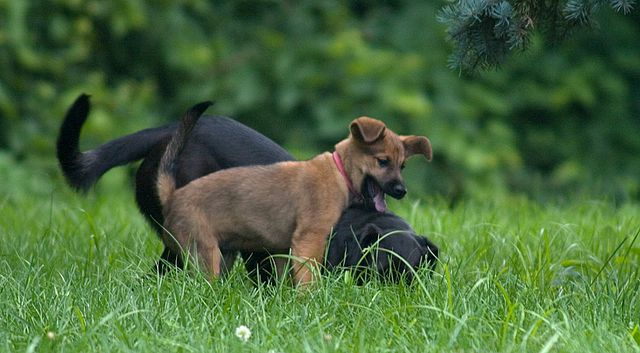
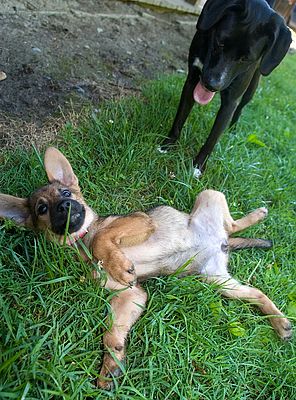
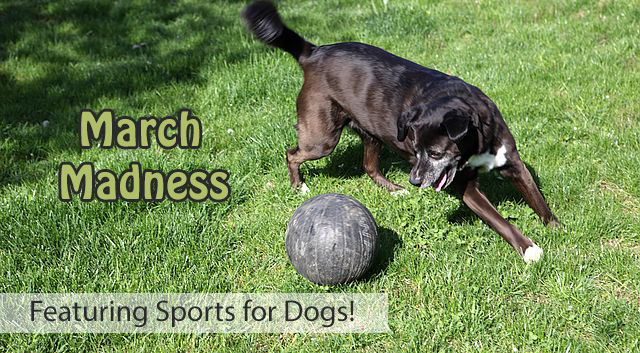 Today’s Wordless Wednesday post celebrates dogs that love playing sports with their humans. It’s springtime and March Madness has just begun, so here’s Haley tipping things off by playing her favorite sport, basketball!
Today’s Wordless Wednesday post celebrates dogs that love playing sports with their humans. It’s springtime and March Madness has just begun, so here’s Haley tipping things off by playing her favorite sport, basketball!